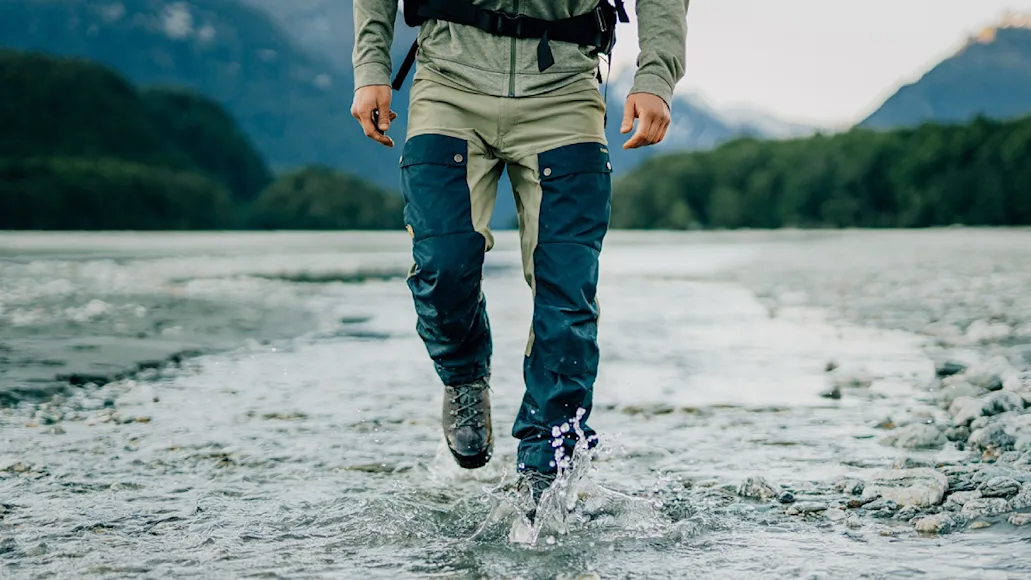_We may earn revenue from the products available on this page and participate in affiliate programs. Learn more ›
_
Best Overall
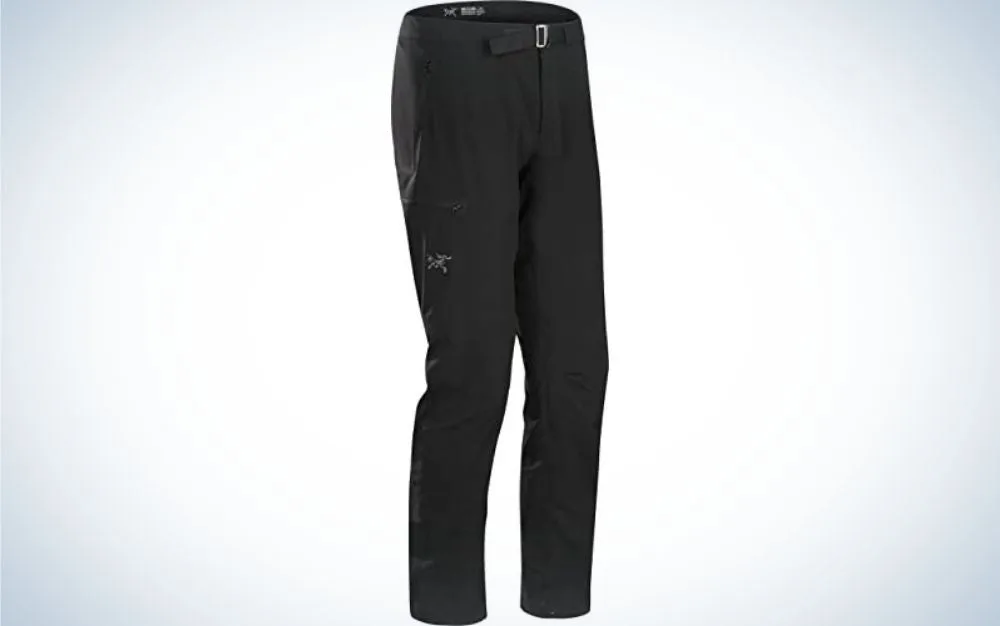
Arc’teryx Gamma LT
LEARN MORE
Summary
The Arc’teryx Gamma LT are a durable, comfortable, and versatile pant that guarantees ample wind and water protection.
Best Convertible

Kuhl Renegade
LEARN MORE
Summary
Kuhl’s Renegade Convertible pants are stylish and practical for various climates and are easy to convert from pants to shorts.
Best Budget
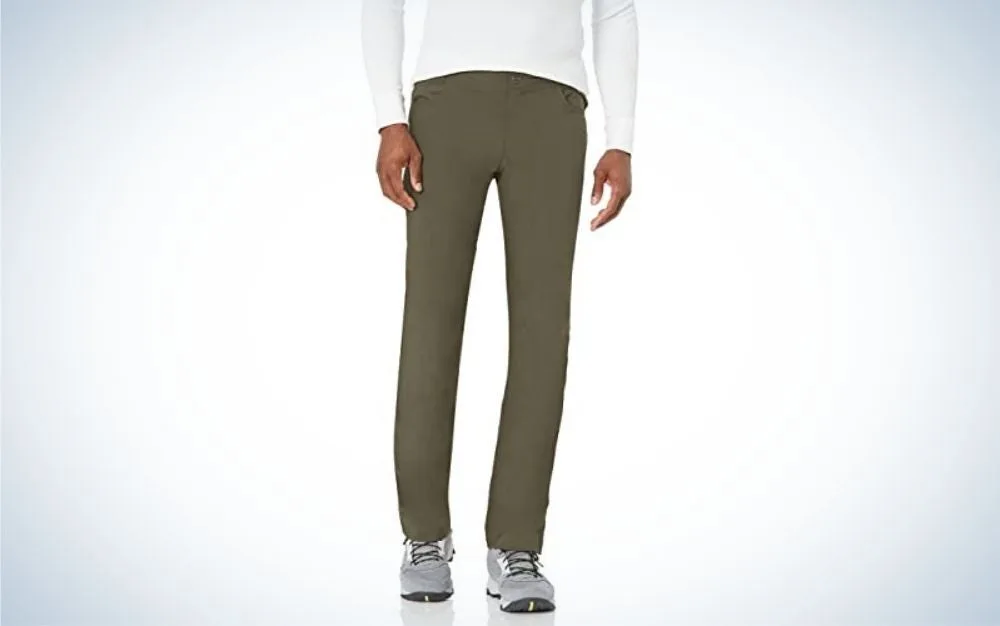
Columbia Pilsner Peak
LEARN MORE
Summary
Columbia’s Men’s Pilsner Peak are our budget pick as they bridge the gap between quality, durable hiking pants and expensive ones.
Hiking pants for men allow for freedom of movement, ample functionality, and the ability to withstand the rough and rugged nature of hiking. Choosing just one pair of pants as the best of the best is a challenge because not only are there various hiking applications and seasons, but we are all individuals with varying needs and preferences.
While we chose some of the better hiking pants on the market to share and review with you today, read through our buying considerations section as well. There you will find how we evaluated and chose the best hiking pants for men, and these categories can help guide your future hiking pant purchase decisions.
Best Overall: Arc’teryx Gamma LT Pant
Best for Winter: Fjallraven Keb Pant
Best Three Season: Coalatree Trailhead Pants
Best Convertible: Kuhl Renegade Convertible Pants
Best Budget: Columbia Pilsner Peak Pants
How We Picked the Best Hiking Pants for Men
Although this is the best hiking pants for men, all genders opt for pants from time to time when it comes to hiking. Many things can influence buying decisions when it comes to your outdoor apparel.
When writing this article and choosing the top picks, I not only took information from the “things to consider before buying” section, but I considered the following criteria:
Function: Identifying your intended use for your hiking pants will help you narrow down the exact functions you deem necessary. All hiking pants need to be optimized for hiking, a style that fits your needs and offers features that enhance the wearing experience. The pant materials should also be considered when looking at functionality.
Durability: If you’re wearing clothing outdoors, it must be durable. With a durable construction and material base, look at company repair policies and overall longevity statements. These should be pants you can wear for several hiking seasons and extended backpacking trips with minimal issues.
Sustainability: The more transparent a brand is about its production practices, the better. They should have clear sustainability standards and be easy to access and understand.
Best Hiking Pants for Men: Reviews and Recommendations
Best Overall: Arc’teryx Gamma LT Pant
Best Overall

Specs
Materials: 88% nylon, 12% elastane
Weight: 11.6 oz
Water Resistance: DWR finish
Pros
Excellent water resistance
Works for three season hiking
Great mobility
Cons
No rear pockets
Arc’teryx has a wide variety of pants to choose from, and many of them are suitable for hiking. The Arc’teryx Gamma LT Pant, in particular, is likely the best in class for versatile weather-protective pants. This pant design allows for top-of-the-line weather resistance from wind and rain while still being lightweight enough to be comfortable for three-season hiking.
They come with an integrated belt to ensure that the pants will continue to fit perfectly even on extended hikes and with extended wear. Some men find the pants to have a somewhat small inseam, but the general flexibility of the material provides plenty of room to move.
Although they are not roll-up style pants, the material is easy to keep rolled up if you are hiking in particularly warm weather. The biggest complaint that people have about these pants is the price point. You will spend a bit more on these pants, but most wearers have found them to be well worth it.
Best for Winter: F
Best for Winter
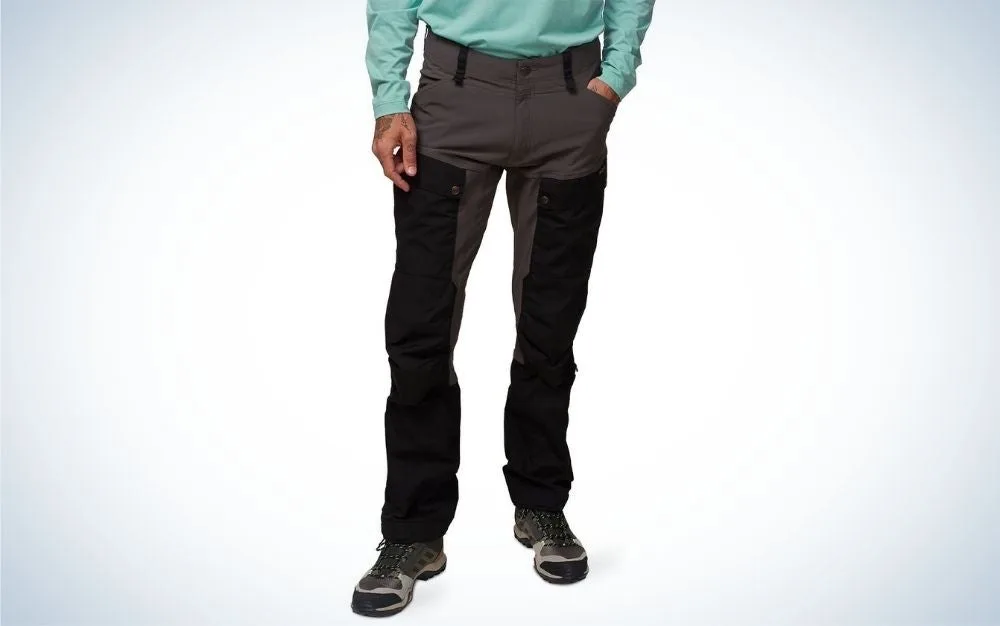
Specs
Materials: Fjäll’s proprietary G-1000 fabric
Weight: 1.4 lbs
Water Resistance: Greenland wax treatment
Pros
Ample water resistance for snow travel
Innovative air flow design
Added panels for durability
Cons
Less flexible than other materials
The Fjallraven Keb Trouser has a unique design and material option. Utilizing the Fjäll’s proprietary G-1000 fabric, and the base is actually a blend of polyester and cotton. Cotton is traditionally a hard no when it comes to hiking, but with the primary material being polyester, added synthetic stretch panels, and the Greenland wax treatment for weather protection, these pants can stand up to mountain treks.
The fabric is tightly woven to improve weather resistance and durability. The added panels on the sides and rear of the pants increase durability and overall protection from the elements. One unique feature on these pants is the zippered leg and thigh openings similar to rain jackets that allow for airflow while hiking without compromising protection.
Fjallraven is well known for its commitment to sustainable manufacturing and design. They pioneer unique fabric blends and outdoor clothing designs for various outdoor activities.
Best Three Season: Coalatree Trailhead Pants
Best Three Season
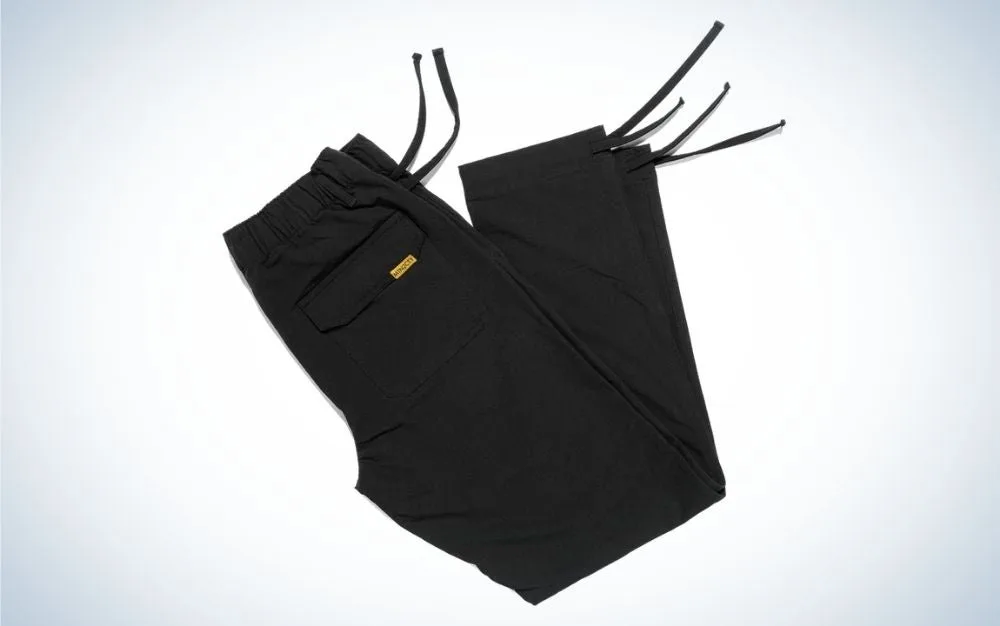
Specs
Materials: Fair Wear bluesign 88% nylon, 12% spandex
Weight: 10.9 oz
Water Resistance: DWR finish
Pros
Water resistant yet breathable
Anti-microbial
Durable ripstop fabric
Lightweight and packable
Cons
Drawstring on waistband and for ankles can be too long and get in the way
Someone looking for excellent all-around outdoor pants that can last them three seasons of outdoor wear will want to check out the Coalatree Trailhead Pants. The Coalatree brand uses Fair Wear bluesign fabrics for all of their clothing and even utilizes a waterless dye.
Beyond their sustainability efforts, their Trailhead pants are an excellent choice for the outdoor generalist. They don’t quite have a roll-up pant design and instead use a drawstring cinching system to allow you to adjust the length of the pants. This is great for converting the pants in different temperatures but also for those that have difficulty finding pants of an appropriate length.
The fabric is water-resistant, extremely flexible, and made from a durable ripstop fabric. The durability does not compromise the weight either. They are lightweight and great for travel since they can pack down into the pocket.
Best Convertible: Kuhl Renegade Convertible Pants
Best Convertible

Specs
Materials: 95% nylon, 5% spandex
Weight: 15.9 oz
Water Resistance: Waterproof finish
Pros
Excellent conversion design
Well designed pockets
Durable materials
Cons
Not very breathable as pants, but look and feel great as shorts
Unlike other convertible pant designs, the Kuhl Renegade Converitable Pants provide a sleek, low-profile zipper system. A zipper connects the pant leg to the shorts, but there is also one that runs up the leg. This makes it easy to vent the ankles if you don’t quite want to commit to converting but also for taking on and off hiking boots.
The pants fit most men a little baggy, which could be a pro or a con. Some find them too loose around the legs, but because the fabric lacks some breathability on its own, the loose fit helps with airflow.
The Renegade pant design utilizes a cargo-style pocket system on the shorts portion of the pants. So, if you like having large, secure pockets when you’re hiking, these are a great option.
Best Budget: Columbia Pilsner Peak Pants
Best Budget

Specs
Materials: 56% polyester, 44% nylon
Weight: 9.6 oz
Water Resistance: Omni-Wick™ technology
Pros
Lightweight design
Flexible fabric for great mobility
Good for warm weather hiking
Cons
Tend to run small
Pockets are a bit awkward
Finding budget hiking pants that will last you a while can be challenging. Columbia offers a few affordable options, but the Pilsner Peak Pants are among our favorites. They utilize a standard hiking pant design with a lightweight polyester and nylon blend. They offer enough stretch and flexibility to allow for plenty of room to move while you hike.
The slim fit provides a secure feel, but some may prefer baggier pants. The weight and breathability of the fabric make them great for warm weather hiking. Plus, they have a UPF rating of 50 for some added sun protection.
It is advisable to reference the size chart closely if ordering online or try them on in person before buying. They tend to run a bit small with a tight waist, and the sizing varies in comparison to other leading outdoor brands.
What to Consider When Choosing Hiking Pants for Men
While it can feel like a pair of pants is just a pair of pants, when you want a pair that can last you several hiking seasons or even for days, weeks, or months at a time when on a long trail, there’s a lot to consider. These buying considerations can be applied to many other types of hiking clothing and can help you make more educated purchase decisions moving forward. That said, here’s what to look for in the best hiking pants for men.
Materials
Understanding the materials of your hiking pants can help you evaluate the pants’ longevity, durability, overall performance, and sustainability before you purchase them. Like other types of hiking clothing, avoid materials (like cotton) that can hold moisture and take a long time to dry. These materials can cause safety risks and general discomfort while walking once they get and stay wet.
Materials you’re likely to see used when shopping for hiking pants include:
Polyester and recycled polyester (rPET)
Spandex
Nylon
Synthetic blends
The majority of brands will blend the synthetic materials listed above. Using a blend of materials allows for a broader application, better mobility, and durability. Some brands that make technical hiking pants may also make casual wear pants. More casual pants are likely to blend synthetics with cotton, which should be avoided for hiking in most circumstances.
Some natural fibers can work decently for hiking pants, but they are almost always blended with synthetic fibers. Since synthetic fibers like polyester gained popularity in textiles in the 1970s, they have become an industry standard due to their affordable price, performance, and durability despite negative environmental impacts.
Style
There are a few very common hiking pants styles and they all have intended applications. Their varied designs work well for different seasons and circumstances, but when choosing a style, it often comes down to what you are most comfortable wearing.
The three most common styles of hiking pants for men include:
Convertible pants: Full-length pants designed to be zipped off above the knee, converting into a pair of shorts. These pants are extremely versatile and work well for hikes that have colder mornings and evenings, but warm afternoons. The downside to these pants is the zipper above the knee. They can cause some chafing as you walk, and general discomfort when you are sitting down for long periods of time.
Roll-up pants: A great alternative to convertible pants, roll-up pants are full-length pants that utilize a button, hook, or drawstring mid-calf to secure the pants when rolled to the desired length. These pants won’t provide as much of a transition as convertible pants, but they tend to be more comfortable and are easier to transition between styles.
Standard pants: Long or minimal pant designs are also known as full-length standard pants. These do no offer a fluctuation in pant length and function only as pants.
A lot of the style decision comes down to personal preference and what you feel most comfortable wearing while hiking.
Durabilty
What materials the pants are made from will influence the durability. In general, synthetic blends are thought to be more durable than single-material fabrics. More specifically, having a material mixed with nylon is more durable because of nylon’s inability to degrade or break down naturally.
When looking at hiking pant durability, it is also recommended to see if there are reinforced seams or panels in high-use areas. Areas like the knees or rear of the pants may have additional panels to prevent premature tearing and can help the pants last longer.
When it comes to textile durability, the tighter the weave, the more durable it will be but the less breathable it will be. So, finding a happy balance between durability and breathability may be difficult, pending the intended use.
Most reputable outdoor companies will have a longevity statement of some kind that outlines how long the pants should last, how to maintain them, and a repair policy. Most apparel companies do not accept repairs for rips caused by general use, but if there is a manufacturing error on the seams or zipper, they may repair or replace them. However, many outdoor companies have begun to roll out buy-back, repair, or replacement programs for all of their apparel.
Breathability
The breathability of hiking pants for men isn’t always going to be a necessity. At times, we are hiking in rainy or winter conditions, and breathability isn’t as much of a priority as water resistance. So, knowing the climate and weather patterns for the area you’re hiking in can help you determine the level of breathability you need.
Hiking can be a high-intensity activity, especially if you’re hiking in an area with rugged terrain. Add the heat of a summer day to that mix, and you want pants that not only breathe and let a little air flow through but will also be quick-drying, so you aren’t drenched in sweat all day.
Lightweight fabrics will be ideal for these types of conditions, along with looser-fitting leg designs. When there is a looser fit, it allows for more airflow through the pants as you walk. You may also want to look for pants with built-in vents or mesh in the pockets for even better breathability.
Opting for convertible or roll-up pants can also improve breathability while hiking.
Protection
Even if you are hiking in the summer months, people choose to hike in pants because it offers a higher level of protection from the elements. There are three categories to look for when seeking out hiking pants:
Sun protection: Since pants cover the entirety of your leg, they already provide better protection from the sun. However, not all fabrics have the same UPF (ultraviolet protection factor). Look for UPF ratings on pants to see how many ultraviolet rays penetrate the material. The higher the UPF rating on the material, the better protection. Things that influence a materials UPF rating include chemical treatments, material dyes, the type of fabric, and how tight the thread is woven.
Water protection: Most hiking pants will have some water resistance, but they’re likely not completely waterproof unless they are rain or snow pants. When looking at the pant’s water resistance, remember that it will impact breathability. The most common coatings used for water protection on pants is DWR (durable water repellent). This solvent-based coating allows the fabric to shed water better and prevents the materials from absorbing moisture. These coatings wear off over time and with washing and will need to be reapplied. There are newer, more eco-friendly water-based coatings being produced, but they have yet to be fully integrated into most company production models.
Insect protection: Since hiking pants cover your entire leg, they will already do a decent job protecting you from insects. Depending on where you are hiking, you may not be overly concerned about getting hiking pants with any insect protection. If you primarily hike in areas with insects like ticks, having treated clothing can be helpful. There are also options to treat clothing with insect protection at home, but these can emit toxic chemicals and fumes harmful to pets and children and should be done with caution.
The type of protection you need in hiking pants will vary according to the intended use and are you are hiking.
Mobility
As mentioned, how pants feel when you wear them is an essential factor in choosing the best hiking pants. General mobility will significantly impact how comfortable you are.
Since most hiking pants are made from synthetic blends like polyester, spandex, and nylon, these will not only be quick-drying but should also offer better stretch, flexibility, and general mobility while moving. Pants that have even a low percentage of spandex built into them will have more flexibility than those made strictly of polyester and nylon.
We recommend trying on hiking pants and hiking shorts in person from time to time. If you are investing in a new style of pants, this can help you determine if you like how they feel and to find the correct sizing. Trying them on also allows you to perform certain movements common in hiking, like high steps or lunges, to ensure they are comfortable no matter what.
If you go to an outdoor retail store to try pants, we also recommend trying them on with a backpack if you plan to hike with one. This way, you can see where the pack sits on your hips and if the pants will cause any sore or hot spots. The best hiking backpacks
will have padded waist support, but if the pant belt digs in, it can still cause chafing.
Even tighter hiking pants should allow for full range of motion and mobility. Many men prefer looser pants for breathability, but no matter the fit, they should be flexible enough to hike and move comfortably. And stay safe out on the trails. Follow the hiking smart guidelines
from the National Park Service. You can also take a look at other recommendations to trail wear. We have roundups of top hiking jackets
, shirts
, socks
, and boots
.
FAQs
Q: What type of pants are best for hiking?
The type of pants best for hiking allows for wearer mobility, offers breathability with some moisture resistance, and is durable enough to withstand outdoor elements. The exact kind of hiking pants that works best for you will depend on personal preferences, your body type, the difficulty level of the hike, and more.
Q: Are cotton pants good for hiking?
No, cotton pants are not good for hiking. Cotton is an absorbent material that takes a long time to dry. So, even if you get them wet in warm conditions, hiking with wet pants will likely cause chaffing. When hiking in cold conditions, wearing cotton clothing becomes more dangerous due to the risk of hypothermia.
Q: How tight should hiking pants be?
How tight hiking pants should be will depend on personal preference. Some hikers prefer a snugger fit to prevent snagging when hiking in brushy areas. Other hikers like the mobility and breathability of looser pants. Trying pants on in-person helps you get the perfect fit and ensure you will be comfortable with how tight they are.
Q: Should my hiking pants be waterproof?
Hiking pants should be waterproof if you are hiking in high precipitation climates or weather. Most hiking pants will have some water resistance, but they will rarely be completely waterproof. Most hikers opt to carry rain pants to put over their hiking pants if there is a chance of rain. Completely waterproof clothing limits breathability and is often too hot to wear unless necessary.
Best Hiking Pants for Men: Final Thoughts
Best Overall: Arc’teryx Gamma LT Pant
Best for Winter: Fjallraven Keb Pant
Best Three Season: Coalatree Trailhead Pants
Best Convertible: Kuhl Renegade Convertible Pants
Best Budget: Columbia Pilsner Peak Pants
The best hiking pants for men will not be the same for every man. With the extent of options available to us, finding pants that keep you comfortable throughout all hiking seasons has become more accessible. Even if you couldn’t find the perfect pair from our top picks, we hope this article provided the tools you need to make an educated choice moving forward.
Why Trust Us
For more than 125 years, Field & Stream has been providing readers with honest and authentic coverage of outdoor gear. Our writers and editors eat, sleep, and breathe the outdoors, and that passion comes through in our product reviews. You can count on F&S to keep you up to date on the best new gear. And when we write about a product—whether it’s a bass lure or a backpack—we cover the good and the bad, so you know exactly what to expect before you decide to make a purchase.

